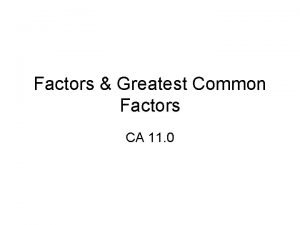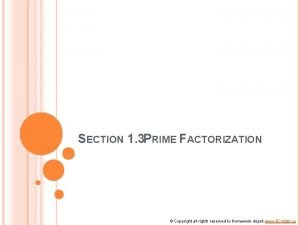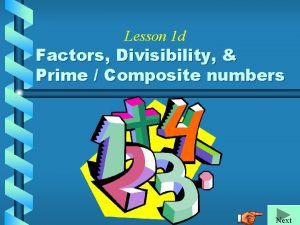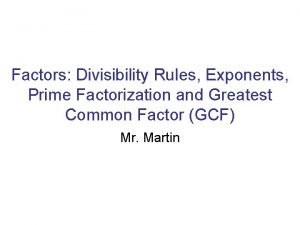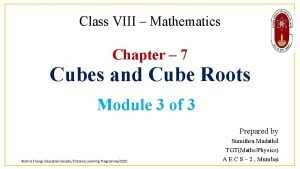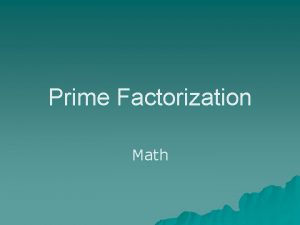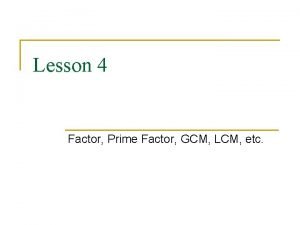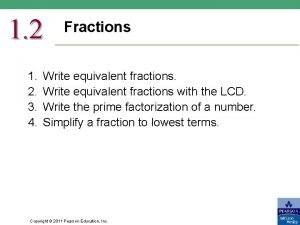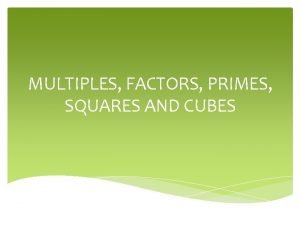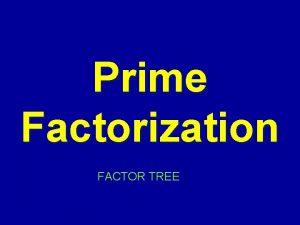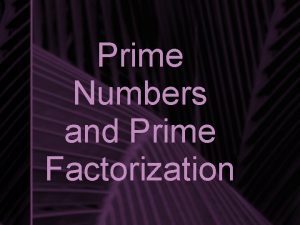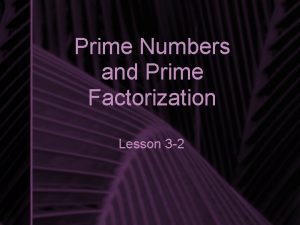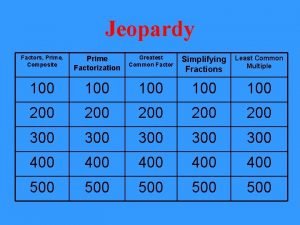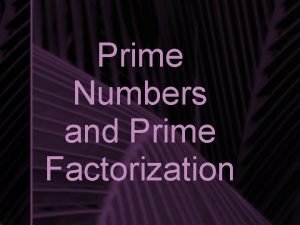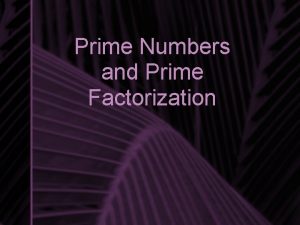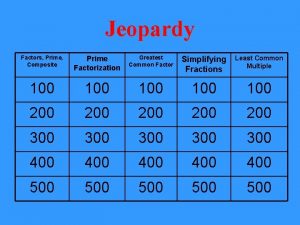3 1 Prime Factorization California Standards Preparation for















- Slides: 15

3 -1 Prime Factorization California Standards Preparation for NS 2. 4 Determine the least common multiple and the greatest common divisor of whole numbers; use them to solve problems with fractions (e. g. to find a common denominator to add two fractions or to find the reduced form for a fraction). Holt CA Course 1

3 -1 Prime Factorization Vocabulary prime number A whole number greater than 1 that has exactly two positive factors, itself and 1. composite number A whole number that has more than two positive factors. prime factorization A number written as the product of its prime factors. Holt CA Course 1

3 -1 Prime Factorization A prime number is a whole number greater than 1 that has exactly two positive factors, 1 and itself. Three is a prime number because its only positive factors are 1 and 3. A composite number is a whole number that has more than two positive factors. Six is a composite number because it has more than two positive factors— 1, 2, 3, and 6. The number 1 has exactly one positive factor and is neither prime nor composite. Holt CA Course 1

3 -1 Prime Factorization Example 1: Identifying Prime and Composite Numbers Tell whether each number is prime or composite. A. 11 The positive factors of 11 are 1 and 11. B. 16 The positive factors of 16 are 1, 2, 4, 8, and 16. So 11 is prime. So 16 is composite. Holt CA Course 1

3 -1 Prime Factorization A composite number can be written as the product of its prime factors. This is called the prime factorization of the number. You can use a factor tree to find the prime factors of a composite number. Holt CA Course 1

3 -1 Prime Factorization Writing Math You can write prime factorization by using exponents. The exponent tells how many times to use the base as a factor. Holt CA Course 1

3 -1 Prime Factorization Example 2 A: Using a Factor Tree to Find Prime Factorization Write the prime factorization of the number. 24 24 8 3 4 2 3 2 2 2 3 Write 24 as the product of two positive factors. Continue factoring until all factors are prime. The prime factorization of 24 is 2 2 2 3. Using exponents, you can write this as 23 3. Holt CA Course 1

3 -1 Prime Factorization Example 2 B: Using a Factor Tree to Find Prime Factorization Write the prime factorization of the number. 150 30 5 10 3 5 2 5 3 5 Write 150 as the product of two positive factors. Continue factoring until all factors are prime. The prime factorization of 150 is 2 3 5 5, or 2 3 5 2. Holt CA Course 1

3 -1 Prime Factorization You can also use a step diagram to find the prime factorization of a number. At each step, divide by the smallest possible prime number. Continue dividing until the quotient is 1. Holt CA Course 1

3 -1 Prime Factorization Example 3 A: Using a Step Diagram to Find Prime Factorization Write the prime factorization of the number. 476 2 238 7 119 17 17 1 Divide 476 by 2. Write the quotient below 476. Keep dividing by a prime factor. Stop when the quotient is 1. The prime factorization of 476 is 2 2 7 17, or 22 7 17. Holt CA Course 1

3 -1 Prime Factorization Example 3 B: Using a Step Diagram to Find Prime Factorization Write the prime factorization of the number. 275 5 55 11 11 1 Divide 275 by 5. Write the quotient below 275. Keep dividing by a prime factor. Stop when the quotient is 1. The prime factorization of 275 is 5 5 11, or 52 11. Holt CA Course 1

3 -1 Prime Factorization Check It Out! Example 1 Tell whether the number is prime or composite. 14 The positive factors of 14 are 1, 2, 7, and 14. 14 is composite. Holt CA Course 1

3 -1 Prime Factorization Check It Out! Example 2 Write the prime factorization of the number. 90 90 45 2 9 5 2 3 3 5 2 Write 90 as the product of two positive factors. Continue factoring until all factors are prime. The prime factorization of 90 is 3 3 5 2, or 2 32 5. Holt CA Course 1

3 -1 Prime Factorization Check It Out! Example 3 Write the prime factorization of the number. 325 5 65 13 13 1 Divide 325 by 5. Write the quotient below 325. Stop when the quotient is 1. The prime factorization of 325 is 5 5 13, or 52 13. Holt CA Course 1

3 -1 Prime Factorization There is only one prime factorization for any given composite number. Example 2 A began by dividing 476 by 2, the smallest prime factor of 476. Beginning with any prime factor of 476 gives the same result. 2 476 2 238 7 119 17 17 1 7 476 2 68 2 34 17 17 1 The prime factorizations are 2 2 7 17 and 7 2 2 17, which are the same as 17 2 2 7. Holt CA Course 1
 Greatest common factor of 5
Greatest common factor of 5 Paths start and stop at
Paths start and stop at 120 prime factorization
120 prime factorization Lesson 1 prime factorization answers
Lesson 1 prime factorization answers Factors of 36 and 24
Factors of 36 and 24 245 prime factors
245 prime factors Find the cube root of 110592 by prime factorization method
Find the cube root of 110592 by prime factorization method What is the greatest common factor of 24 and 32
What is the greatest common factor of 24 and 32 Prime factors of 8
Prime factors of 8 Gcm lcm
Gcm lcm What is the prime factorization of 80 using exponents
What is the prime factorization of 80 using exponents Prime factorization of 90
Prime factorization of 90 Factor tree of 48
Factor tree of 48 Prime factorization of 200
Prime factorization of 200 120 prime factorization
120 prime factorization 56 prime factorization
56 prime factorization
